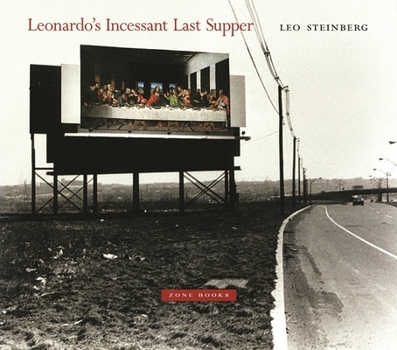Leonardo's Incessant Last Supper
Select Format
Select Condition 
Book Overview
A fresh look at the multiplicity of meanings in Leonardo's Last Supper. A picture universally recognized, endlessly scrutinized and described, incessantly copied, adapted, lampooned: does Leonardo's near-ruined Last Supper still offer anything new to be seen or to be said? This book is a resounding Yes to both questions. With direct perception---and with attention paid to the work of earlier scholars and to the criticism embodied in...
Format:Hardcover
Language:English
ISBN:1890951188
ISBN13:9781890951184
Release Date:May 2001
Publisher:Zone Books
Length:320 Pages
Weight:3.50 lbs.
Dimensions:1.1" x 10.8" x 9.3"
Age Range:18 years and up
Grade Range:Postsecondary and higher
Customer Reviews
2 ratings
I love da Vinci's Last Supper...and this book
Published by Thriftbooks.com User , 20 years ago
Leo Steinberg wrote a very intellectual, rigorous book about Leonardo da Vinci's Last Supper. I liked the way it gave so many fresh perspectives on how to analyze and interpret the painting. The genius of the book is that is amalgamates an enormous amount of information about the Last Supper...and somehow leaves you feeling that only part of the information has been uncovered. It's a feeling of ambiguity; so much has been learned, but we have so much more to discover. Just like da Vinci would have wanted! Steinberg is a great author for this subject. I will leave most of the surprises and delights of the book for you to discover, but consider: Steinberg writes about connections between pairs of apostles in the painting (threes are not only significant, and in fact are probably less significant); he shows how Leonardo possessed an advanced understanding of perspective and created an impossible location; and the book contains an overview of (da Vinci) Last Supper copies throughout history. I do not recall Steinberg discussing John the Baptist as actually being a woman or more speculative aspects of the Last Supper such as secret society messages. Leonardo's Incessant Last Supper attempts to give an analysis of the painting that unearths why and how Leonardo da Vinci painted it, and in my view Steinberg comes closer than anyone I have read. econ
The Way to Look at a Classic
Published by Thriftbooks.com User , 23 years ago
You have seen the image hundreds of times. It has been copied and parodied relentlessly for over five hundred years. It shows Jesus at the center of a dining table, flanked by six disciples on either side. Everyone knows _The Last Supper_, but few know as much about it as Leo Steinberg, who has looked and written and thought about it for thirty years. The result of these decades of concentration are poured out in _Leonardo's Incessant Last Supper_ (Zone Books), as close an examination of a painting as you will ever find. The book is not about the painting's history, its decay, or its restoration; it is, in astonishing detail, about the looks of the picture itself and a demonstration of how it continues to be an "incessant" font of thought and speculation as to its meaning. Steinberg's big book is wonderfully well illustrated, with details from the original, a generous gatefold to show it in its current restored state, pictures of how it looks within the refectory of Santa Maria delle Grazie, how Rubens, Van Dyck, Rembrandt, and a host of others copied the painting (and how they left out significant parts, and what the omissions mean), and plenty of diagrams to show such things as the lines of perspective and the effects of matrices and diagonals on Leonardo's meticulously planned original. Steinberg has chapters on the disciples, on feet and hands, on the disciples, and more. The main figure, that of Jesus, bears, of course, the closest examination, and Steinberg details the history of thought about it, with writers weighing in on the meaning of the pose and the timing within the Gospel story of the scene depicted. Over and over, Steinberg shows that to seek a meaning and a timing is in vain. Leonardo has deliberately engineered his work so that any explanation involving a single meaning will be an oversimplification. Jesus's right hand is downturned in a gesture of apprehension. It is close to a mirror image of the left hand of Judas as they reach simultaneously towards the dish by which Jesus will designate his betrayer. It is also gesturing towards the wine, so that it marks the institution of the Eucharist; after reading Steinberg's work, the idea that Leonardo drew these two separate parts of the story together and told them as one is only one of the multiple meanings that seem natural on further reflection. Jesus's left hand is upturned, gesturing toward the bread. It also underlies the portentous hand of Thomas, hovering directly above it. Thomas's hand has an index finger pointing up, continuing the upturn theme of Jesus's left, and indicating, of course, higher things. It is Thomas's index finger that would soon be feeling around for confirmation of Jesus's wounds.To read this book is to appreciate a hundred telling details in the painting which one did not notice before, and consequently to admire Leonardo's genius anew. It is also to admire the fruition of the decades of Steinberg's close study. His readers may feel





